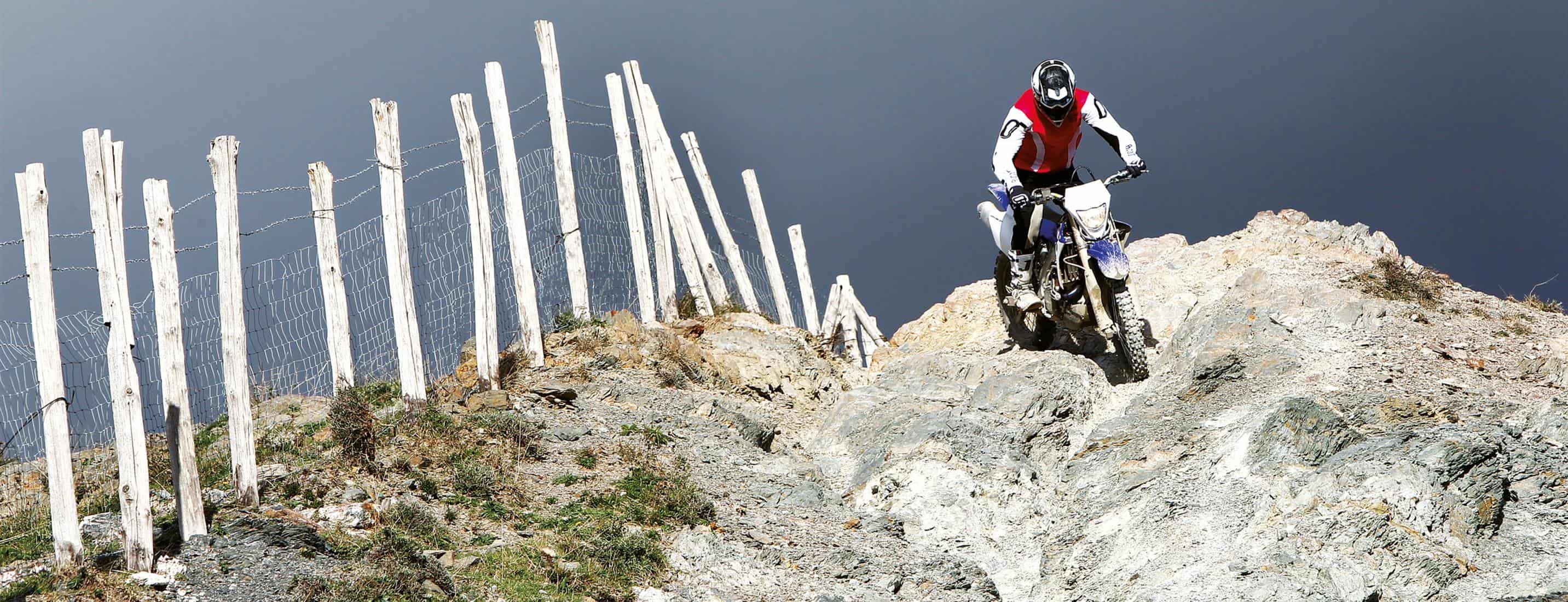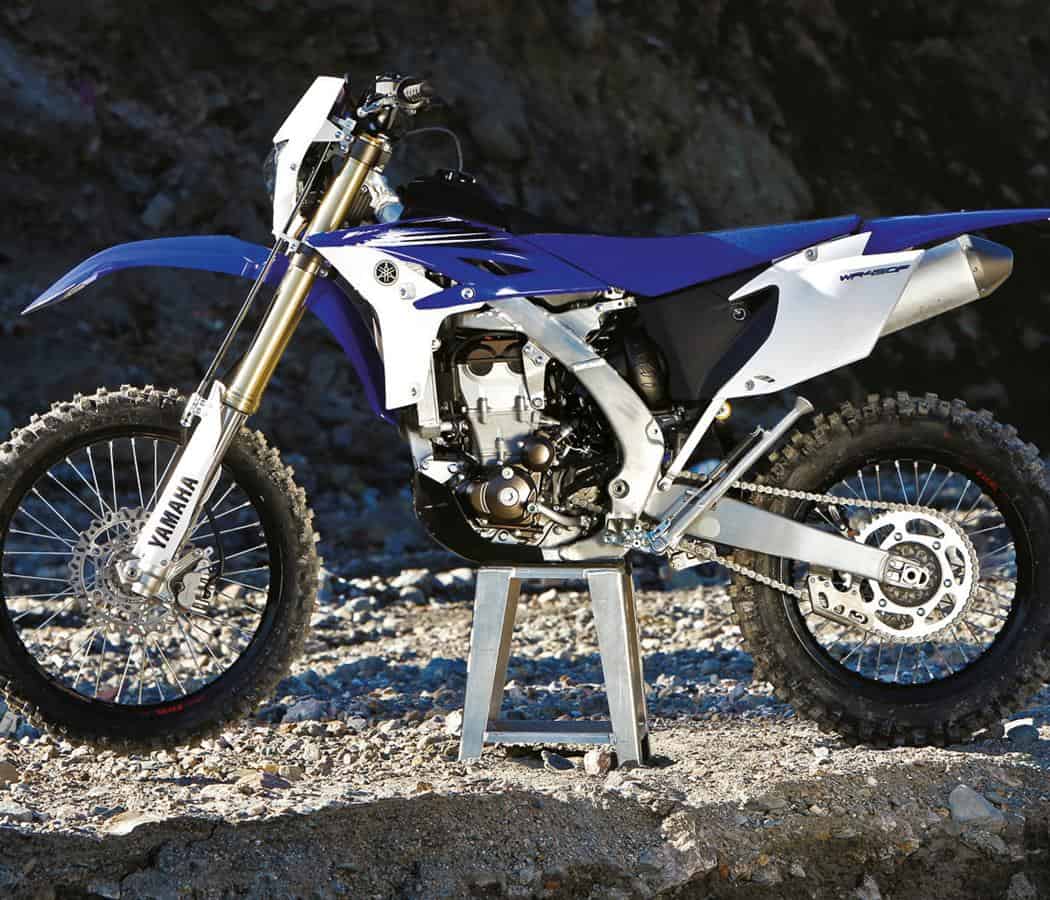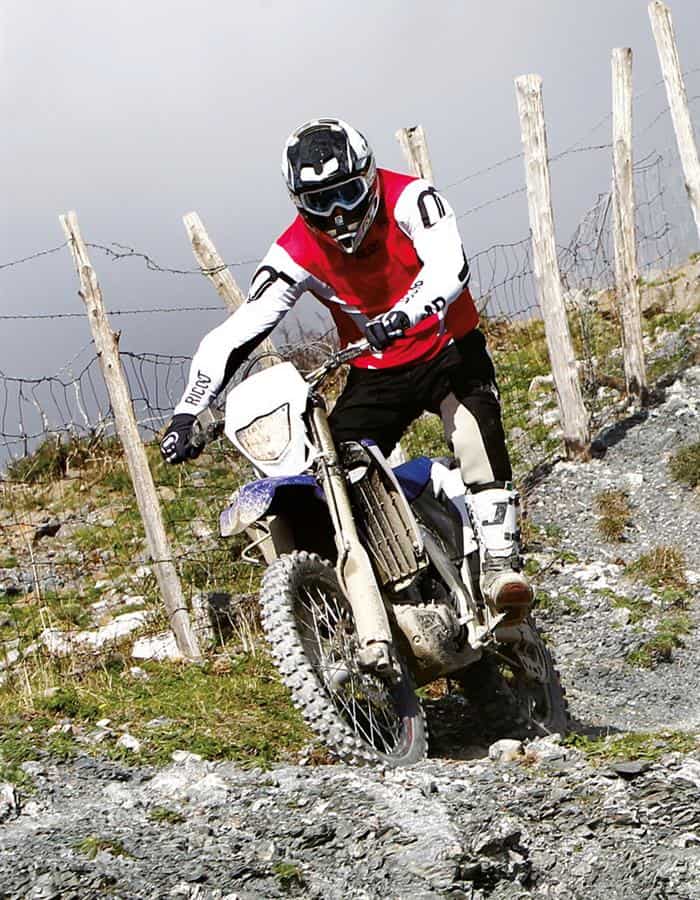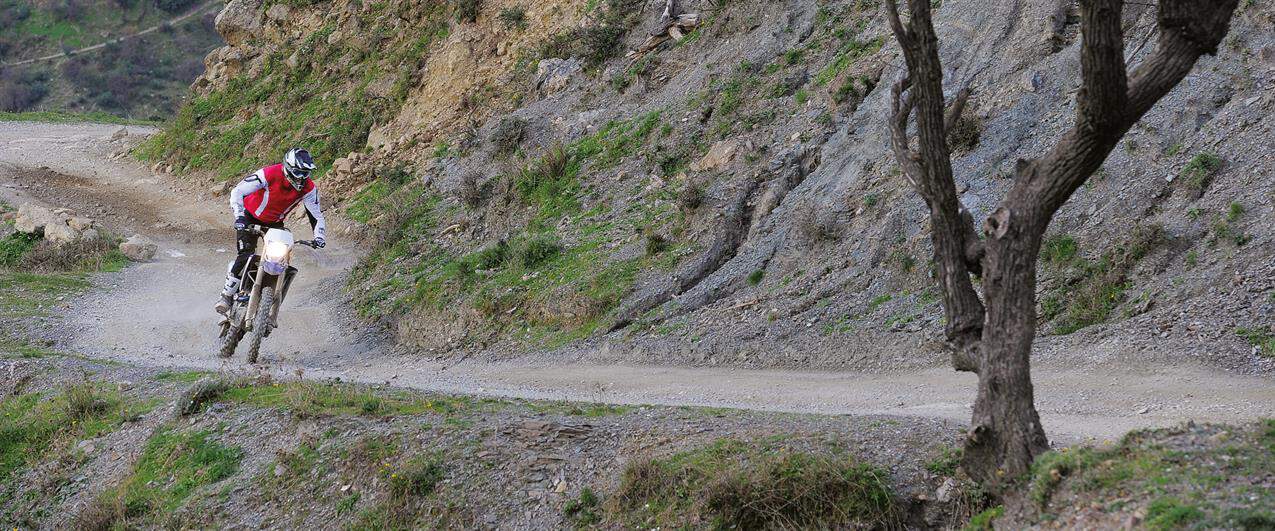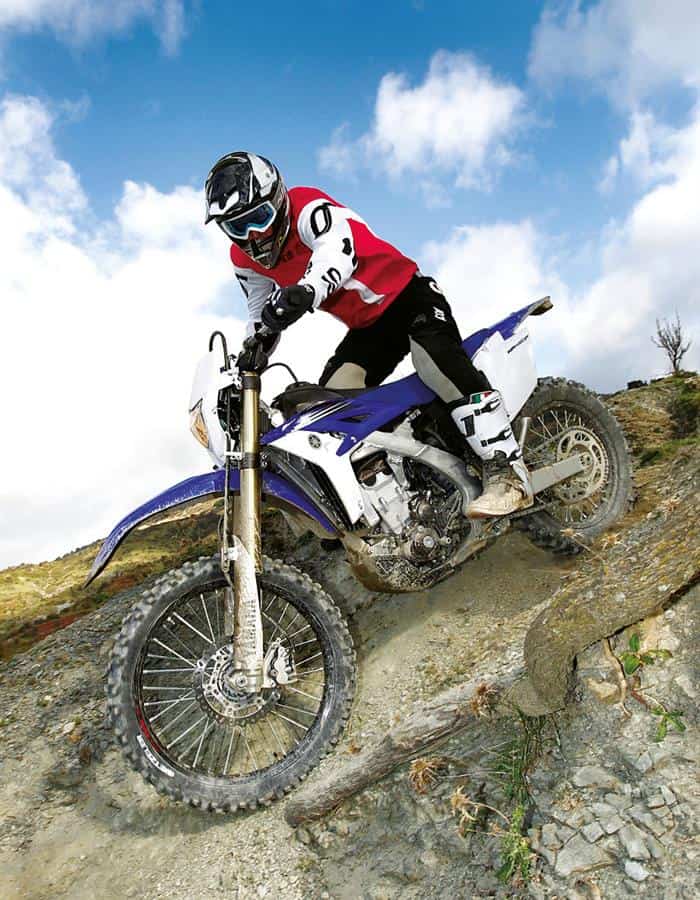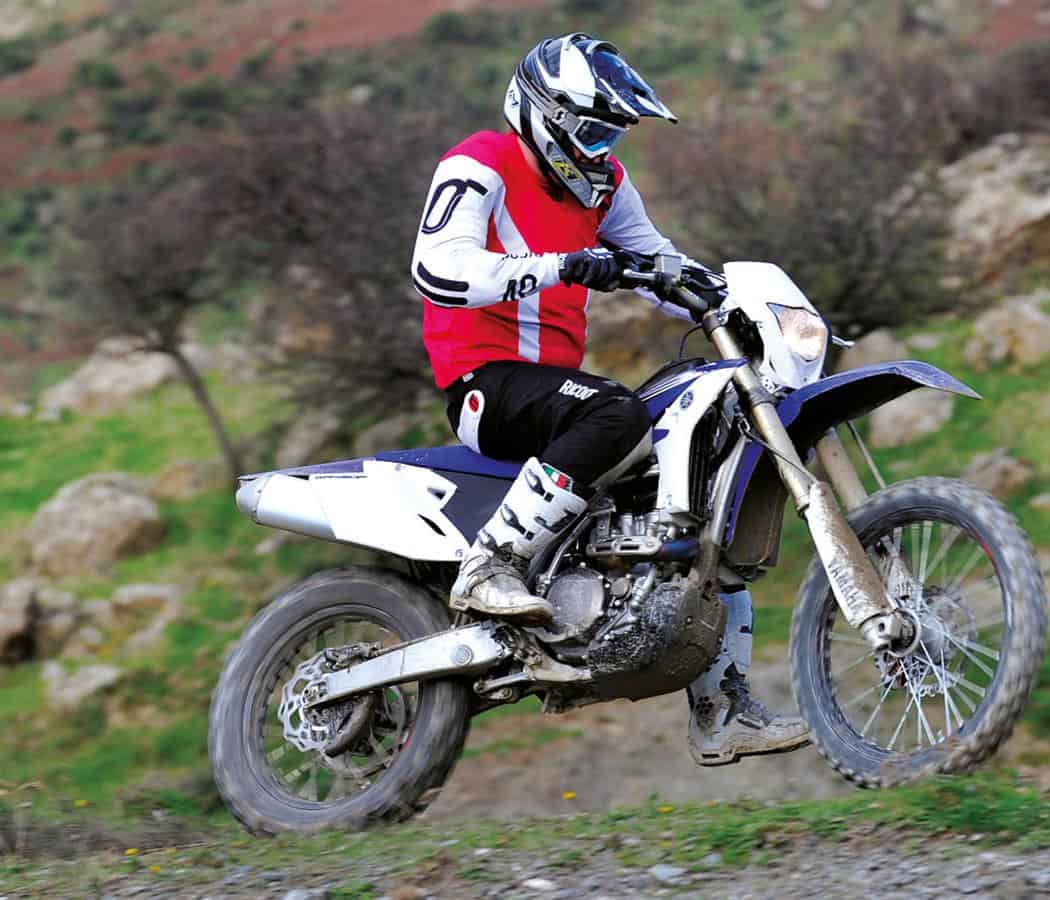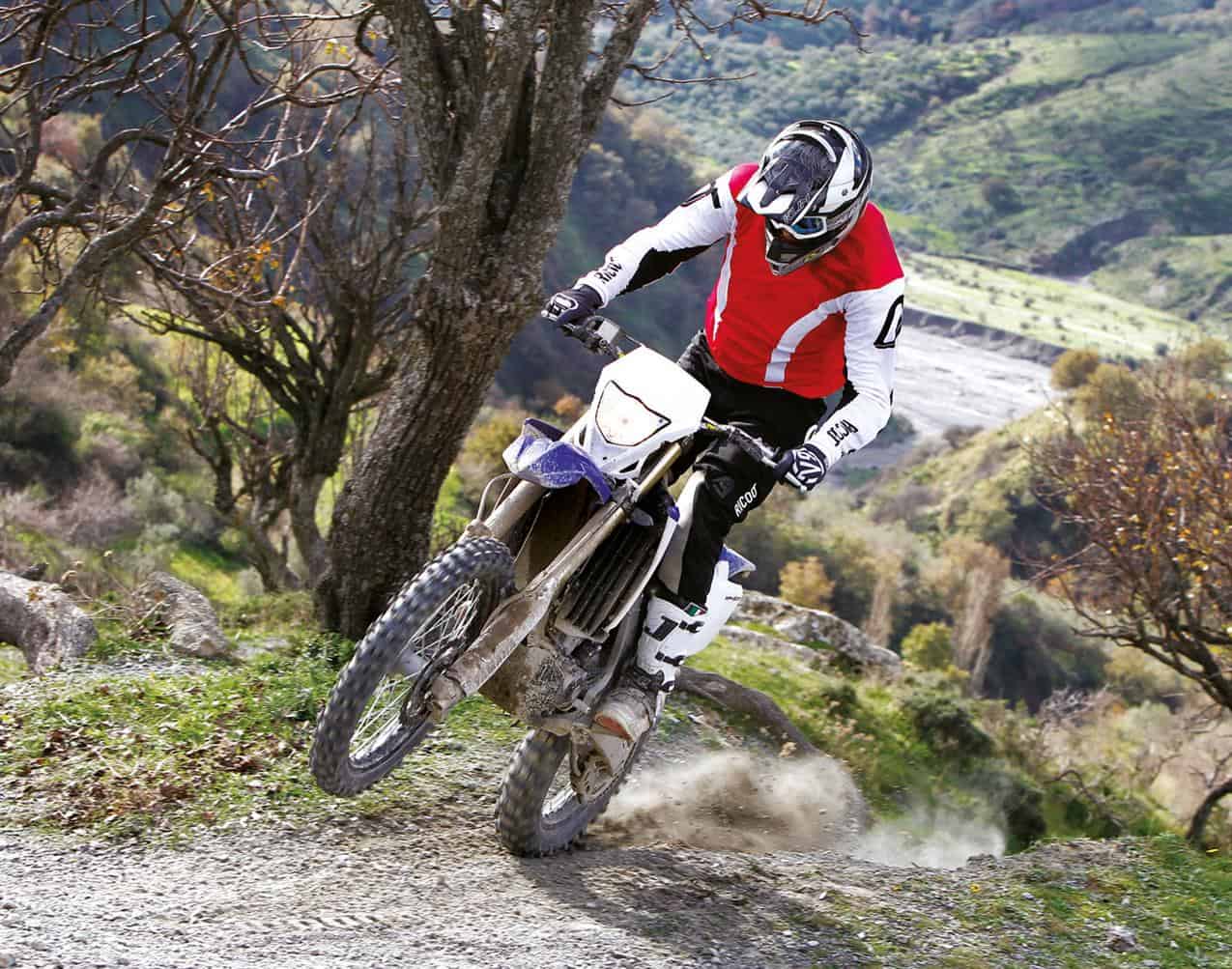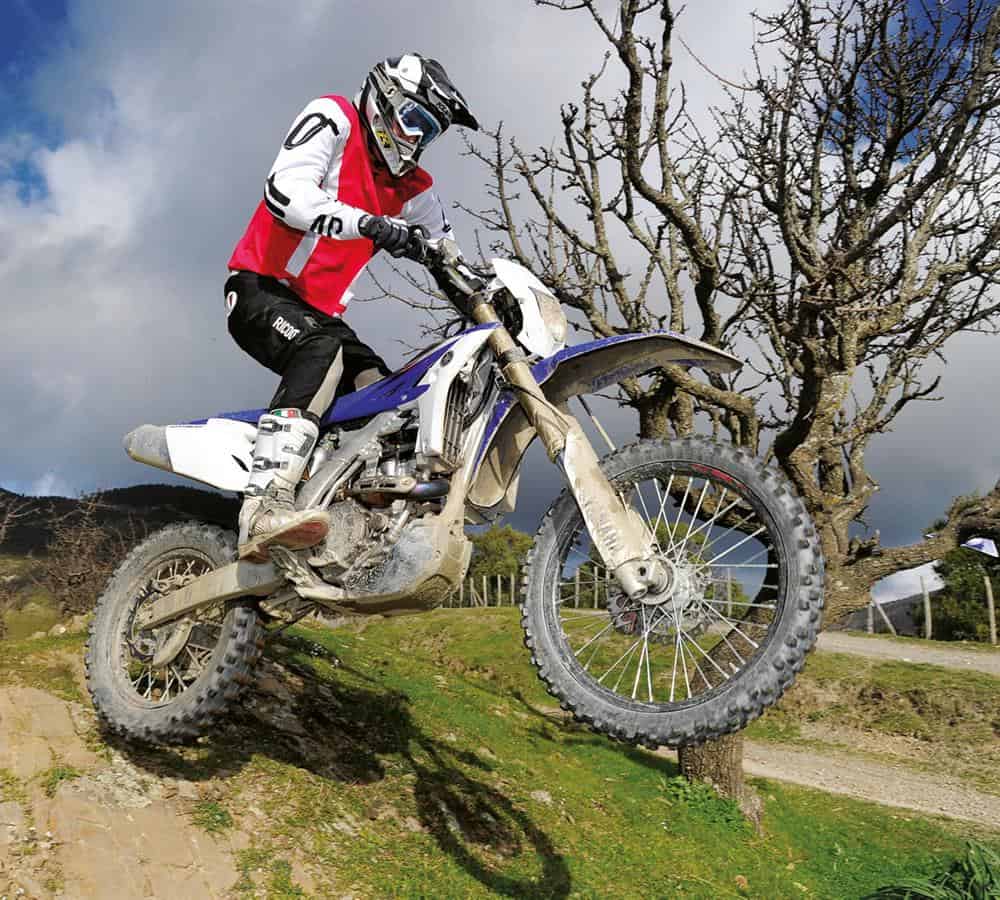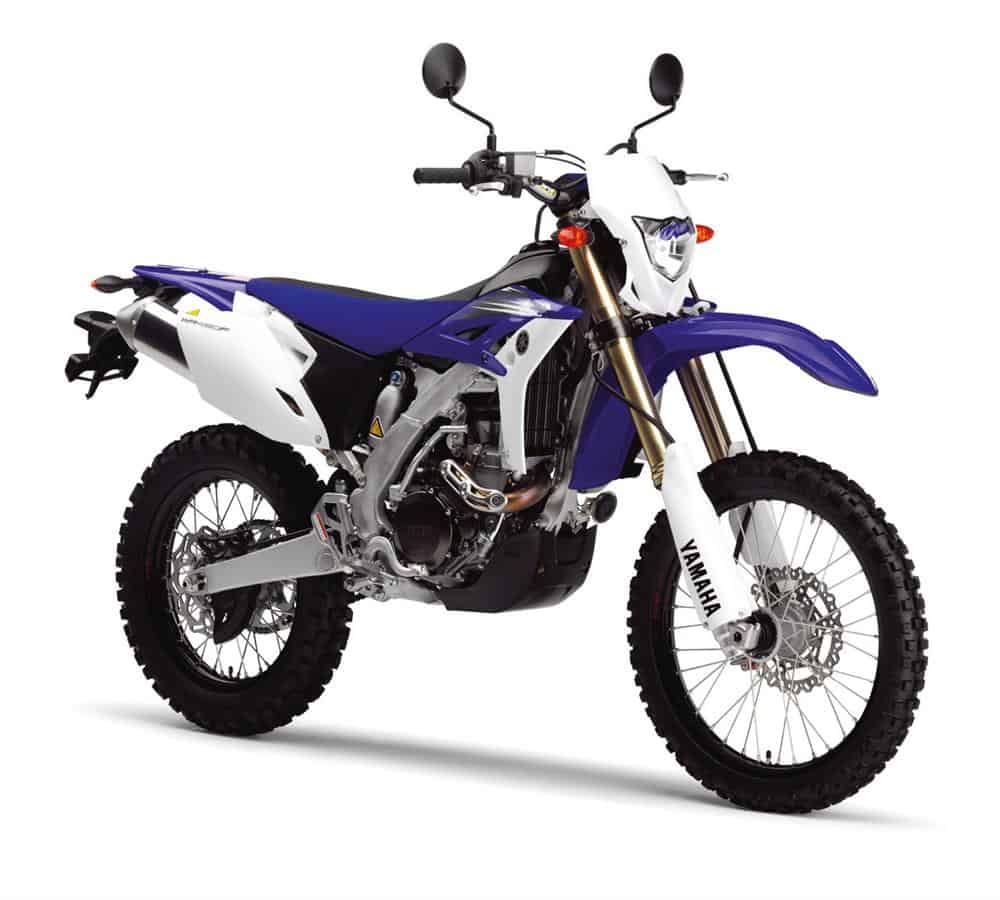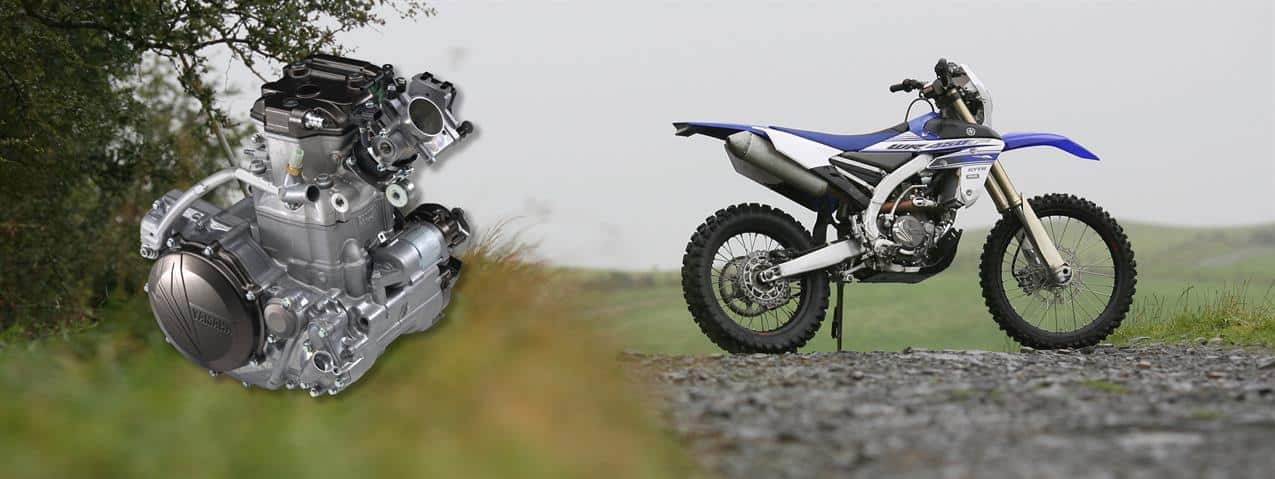Back in 2012 Yamaha’s new WR450F costs nigh-on eight grand! Is it worth the money? Rust Sports’ Barni flew to Sicily to find out…
What have deadly spiders; being eaten by sharks; and Yamaha’s WR450F got in common? Give in? They’re all popular Down Under..! If they’ve not been fatally bitten by a Funnel-web or devoured by a Great White, Bruce and Sheila buy so many of the big blue 450s that it’s previously been the biggest selling bike in Australia. That’s not to say it was merely the biggest selling ENDURO bike, but the biggest selling motorcycle fullstop! Why? Well the Aussies love their dirtbikes and the blend of a big stable chassis, strong power and an unburstable engine perfectly suit the fast trails and wide open spaces they have to play in.
Sadly, whilst we here on the opposite side of the world also appreciated the motor’s longevity we didn’t like the mix of a long chassis and a DOHC lump with dragster-like performance. It was simply too big ‘n’ fast for the UK and European enduro scene, and even for our comparatively compact and generally snotty network of trails too. Plus, when you consider that since it gained an alloy beam frame back in ’07 it’s seen almost no updates other than piling pounds onto the pricetag, well, it’s just never been that popular.
Maybe that’s about to change. For 2012 the bike has been reworked – moving away from being a straight-line rocketship, Yamaha have sought to make the WR more compact, more nimble, and, well, more ‘European’.
We’d have loved to have seen the same level of development and innovation that was put into the current YZ450F applied to the WR-F, but in the eyes of the Japanese manufacturers enduro has traditionally played second-fiddle to MX and money is tight. So the bike isn’t new from the ground up, and nor does it employ the rearwards slanting barrel of its motocross counterpart. The YZ-F is a fearsome beastie, and not the ideal basis for an enduro machine.
In many ways, we’ve always said a similar thing about the powerhouse WR450F motor – though its just plain fast rather than MX feisty – and weren’t exactly cock-a-hoop when we learnt that the 2012 bike was going to retain the dry-sumped, DOHC, five-valve lump from the 2011 bike. Still, it has come in for a few changes, the largest of which being the adoption of fuel injection (Denso injector, Keihin 42mm throttle body), and Yamaha have made the well-proven engine even more reliable by the fitment of a larger big-end bearing and an additional five-percent cooling capacity.
By far the biggest change is where they’ve put the motor – into the alloy bilateral beam frame from the 2012 YZ250F (lightly tweaked to accept the physically larger 450 lump). And with the new frame comes new suspension. Kayaba front and rear, the 48mm forks are closed cartridge units (where the oil and air is kept apart) and offer 300mm of travel, whilst the lower fender on the rear of the WR has forced a drop in rear-end travel to 299mm – still more than enough. Naturally, the suspension’s all fully adjustable.
Compared to the outgoing 450, the new bike gets a much flatter profile from gascap to rear fender and, cosmetically, has been brought into line with the current YZ-Fs. The overall look is modern without being too minimalist (you can still easily fit race numbers on the sidepanels) though there’s no disguising the fact that the WR-F motor is physically large and although the bike wears a plastic bashplate you have to look to the accessories list or the aftermarket for some handguards.
An Eight Grand Day Out
And so to the launch in Sicily: the Italian island famed for its active volcano, Mount Etna, and the equally unpredictable (not to mention explosive) driving style of its inhabitants. It was also host to the Italian round of last year’s Enduro World Championship, and indeed our test loop started out on the very same riverbed as the EWC’s motocross test.
In the run-up to the launch, heavy rain had swelled the waters to an angry torrent and gnawed away at the riverbanks. Thankfully, by the time we arrived the water had subsided and the only signs of any flooding were the numerous uprooted trees caught on the rocks, and the skip-loads of rubbish dangling from their branches like landfill tinsel.
Winding alongside the river, occasionally crossing its now-trickling waters, the early stages of the test loop were a glorious blend of fast straights, flick-flack chicanes and constant-radius turns, running across a constantly undulating mix of hardpack, loose gravel, and rock. Fast, roll-on roll-off, going – 450 territory for sure. And I loved it!
The WR’s strong midrange fired the bike out of the slower turns, and you just nudged the top-end before slowing for one of a series of esses. The back-end drifted as you crested yet another rolling undulation, and the front wheel remained airborne until the middle of the ‘S’, before touching down just in time to change direction. With the new shorter chassis I expected the bars to waggle and the whole bike shimmy as it ‘landed’ crossed-up, but it simply pointed exactly where I wanted it to and continued gobbling up the trail. A large portion of the old 450F’s stability has been retained…
As we started to climb, the going became far slower. We zigzagged up the hillside through hairpin after hairpin, each one slightly different from the last. Some were sharp, with an awkward ‘ledge’ to negotiate as the trail changed direction; others were flatter or lightly bermed. And until you got there you never know whether the corner was going to be rock-strewn or greasy with mud. On the old 450 it wouldn’t have been much fun at all. That bike did fast, and it did straight lines, but tight turns required real rider input and physical effort. The 2012 bike’s different. The smaller chassis has done away with that big ol’ battleship feeling. Now there’s no need to fight it, just pick a line and stick it in! If you’re coming from a KTM or modern Husaberg then don’t expect to be blown away by its agility, but if you’re chopping in an old WR-F then you’ll certainly welcome the change. (Further helping the handling is the use of a 130-section rear tyre – specially produced for the bike by Metzeler – as opposed to the 140-section rubber more commonly found on E2 class bikes.)
Getting out of the hairpins quickly was more of an issue than getting round them. The DOHC 450 motor has lost none of its oomph, if anything it felt a bit fitter in the midrange, and if you’re getting giddy with the gas you need to be ready to counter any back-end slide as the power quickly builds. That said, there is still that slight ‘turbine’ feel to the power delivery – similar to that you get from a Triumph triple – where the motor immediately responds to the throttle but unless you’ve got it absolutely buzzing it needs to spin-up a little before really delivering the power.
The throttle response itself is wonderfully smooth – if Yamaha had told us it still had a carb I’d have no reason to doubt them. Sometimes fuel injection can make a bike harder to ride, especially a big-cc thumper, by making the motor simply too responsive. Fear not, this certainly isn’t the case here!
Middle Eight
On the narrow woodland trails, at second, third, occasionally fourth gear speeds, the Kayaba suspension was absolutely bang-on. Leaning towards the soft side of plush, it gave fantastic feedback and an incredibly comfortable ride, with the kind of smooth action you get from quality units. The springs match the damping and there’s no discernible ‘spike’ as it suddenly firms up. On the aforementioned, and far faster, riverside track it’d coped with everything I’d asked of it without wallowing through the flowing bends or bottoming on the numerous washouts. Only when flat-landing from a four-foot ledge, or on the final stretches of riverbed (more on which later) did I feel that it could do with stiffening up, which leads me to think that racers (from quick clubman upwards) will want to run it firmer to cope with bigger hits at faster speeds.
Technical terrain was never the WR’s strong point, and the shorter chassis does help when tackling the nadgery stuff. However, it still isn’t the bike’s forte. On flowing terrain the bike doesn’t feel particularly hefty – it’s when you get it in amongst the rocks and roots you notice that it’s carrying a few extra kilos. The spec sheet claims 129kg wet, though fortunately this is with all of the homologation kit fitted and in competition trim this should drop by a handful of kilos. Nonetheless, it still feels a little weightier than some of the 450 opposition, who sit south of 120kg fully-fuelled.
Right off idle, the power is a little on-off and requires a few hundred more revs before it smoothes out. So it demands some very precise throttle control to coax it over big rocks at walking pace or when trying to maintain traction on a slippery hill. Conditions on the launch were largely dry – only on one impromptu hillclimb through the trees was the ground particularly snotty – so it’s probably best that we reserve judgement on the bike’s wet weather performance until we can get one on UK mud. The WR-F was always far better in the dry than the wet…
Should the bike cough stall, which did occasionally happen at low revs though wasn’t a recurring issue, it wouldn’t start in gear and required knocking into neutral before it’d fire-up again. The cable-clutch, with its curiously large lever, is one-finger light though it’d be nicer, and lighter still, if it were a hydraulic unit.
A reasonably narrow cockpit (with a seat which treads a fine line between racy and slim, and trail-comfortable) helps whilst tackling the terrain and although the radshrouds seem to extend a long way forward they didn’t hinder foot-out cornering or snag on my boots.
The riding position is best described as neutral. The seat is a claimed 960mm, though it doesn’t feel quite that tall once you’re onboard, and the height of the Pro Taper bars will suit those around 5-10, 5-11 or so. At 6-1 I found them just a little too low for standing up on the trails and about the perfect height for sat down cornering through the numerous hairpins. That’s with the asymmetric mounts on their highest setting, so shorties will easily find a set-up to suit.
Eight Ball
Descending from the hills, it was back out into the riverbed for the final stretch of the lap. Only this time our route stayed away from the firm ground of the gravel track and instead took us straight down the middle of the river. Deep sandy shale, small rock-fields, the odd drop-off and the occasional stream crossing demanded constant concentration. Let your speed drop and the going became hard work as the ground sucked the life from the motor and pulled the front wheel this way and that. Allow your mind to wander or your eyes to stray to the surrounding scenery and it would be all too easy to find yourself hitting a rock and cartwheeling onto the unforgiving terrain. And this riding really suited the WR-F. The strong, linear power made it easy to maintain speed and the reassuring handling made changing lines a breeze. When you did have to charge across the rocks, the chassis was unflinching. I could’ve played there all day!
This was really the only time on the lap where you could really make use of the motor’s top-end and whilst the bike’s still incredibly fast it’s not quite as strong up-top as I remember it being a few years back. We found similar when we rode a 2011 bike, so perhaps the factory have knocked a little from the top-end.
After Eight
Whereas the old models were better suited to the open expanses of the Australian bush or American boonies, Yamaha have finally turned the WR450F into something that works in European conditions too. It goes round corners yet is stable on the straights. It’s nicely specced and well-equipped (a road kit at last!). And it retains that legendary WR-F reliability. Personally, I found it confidence-inspiring and almost certainly the most rounded of the Japanese 450s. But two factors conspire against it…
Firstly, there’s the changing face of the E2 class. Full-fat 450s are falling out of favour and semi-skimmed 300-400cc bikes are taking over. Many of us, especially racers, are trading prodigious power and torque for a lighter feel and easier-riding. For the UK market there’s no doubt that a revised 250F (or perhaps a WR300F?) would’ve been a better prospect, though less popular in those countries where the 450 has traditionally sold well.
There’ll always be those who like 450s, so a bigger issue is the hefty pricetag. At £7899 it’s considerably more expensive than the Japanese opposition (even if it is the most up-to-date, and arguably best specced) and pricier than ALL of the Euro brands too. A 450EXC is almost a grand cheaper and even an E2-class TM thumper will cost you £500 less. Well built? Certainly. Reliable? Undoubtedly! Easy to ride? Yup, it ticks that box too. But truly worth so much more than the opposition? If you’re a dyed-in-the-wool Yam-fan and are in the market for a 450 you’ll maybe think so. If you’re not, then you almost certainly won’t!
Yamaha WR450F
Price: £7899 (in 2012)
Engine: DOHC, 5-valve, dual start, dry-sump four-stroke
Bore & stroke: 95 x 63.4mm
Displacement: 449cc
Transmission: 5-speed
Frame: Aluminium bilateral beam
Front susp: 48mm Kayaba USD closed cartridge fork
Rear susp: Kayaba shock
Front brake: 250mm floating disc, Nissin two-piston caliper
Fuel capacity: 7.2L
Wheelbase: 1475mm
Seat height: 960mm
Weight: 129kg (claimed, homologation spec and fuelled)
Contact: Yamaha UK on 01932 358000 www.yamaha-motor.eu/uk/index.aspx
Road Works
Whilst the bikes on the launch were in off-road trim that’s not how they’ll arrive in the UK. Take a quick glance at the picture here and you’ll spot the roadkit – mirrors, indicators, giant numberplate hanger: the kind of stuff that most people strip off and store in a box somewhere. But whether the parts would end up cluttering your loft or not, they’re a welcome addition and an indication that the 450 now comes fully homologated and ready for the road. Yep, there’s no need to look to the aftermarket for road legal lighting, nor endure the misery of your local DVLA office to get the bike registered. As it comes, it’s a ‘road’ bike.
Of course, Yamaha know that few (if any) of us are going to ride the bike in that trim, so they offer an ‘optional’ competition kit. We say ‘optional’ because if you REALLY don’t want the free-flowing exhaust system, with its alloy silencer and resonator-equipped header for better torque, nor the 13/50 gearing (to replace the 14/47 road cogs), minimalist bar switches, or the ability to fine-tune the EFI with the Power Tuner accessory, then you don’t have to have it. But you’d be mental not to order it, if for no other reason than it’s FoC! So, like the European brands, Yamaha are offering the bike in homologated trim, road registered and ready to roll. It’s between you and your dealer whether you take delivery with the road gear, or the competition kit, fitted. And before you ask, no, the competition exhaust isn’t a rorty open pipe. In fact, it’s incredibly quiet!
Click the link to read how the Dylan Jones and the guys at Yamaha Off Road Experience (YORE) managed to tame the beast. Using data from some Australian contacts and Yamaha’s plug-and-play Power Tuner to adapt the mapping to make the bike more suitable to ‘European’ conditions. Read on…
Also click on the link to the right for video from the WR450F launch…
Another link you may like will take you to the RUST Magazine Yamaha WR450F Special Issue. Enjoy! https://rustsports.s3.amazonaws.com/YamahaWR450FRustSpecial.pdf

